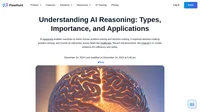A hallucination in language models occurs when the AI generates text that appears plausible but is actually incorrect or fabricated. This can range from minor inaccuracies to entirely false statements. Hallucinations can arise due to several reasons, including limitations in the training data, inherent biases, or the complex nature of language understanding.
Causes of Hallucinations in Language Models
1. Training Data Limitations
Language models are trained on vast amounts of text data. However, this data can be incomplete or contain inaccuracies that the model propagates during generation.
2. Model Complexity
The algorithms behind language models are highly sophisticated, but they are not perfect. The complexity of these models means they sometimes generate outputs that deviate from grounded reality.
3. Inherent Biases
Biases present in the training data can lead to biased outputs. These biases contribute to hallucinations by skewing the model’s understanding of certain topics or contexts.
Detecting and Mitigating Hallucinations
Semantic Entropy
One method for detecting hallucinations involves analyzing the semantic entropy of the model’s outputs. Semantic entropy measures the unpredictability of the generated text. Higher entropy can indicate a higher likelihood of hallucination.
Post-Processing Checks
Implementing post-processing checks and validations can help identify and correct hallucinations. This involves cross-referencing the model’s outputs with reliable data sources.
Human-in-the-Loop
Incorporating human oversight in the AI’s decision-making process can significantly reduce the incidence of hallucinations. Human reviewers can catch and correct inaccuracies that the model misses.
The Inevitable Nature of Hallucinations
According to research, such as the study “Hallucination is Inevitable: An Innate Limitation of Large Language Models” by Ziwei Xu et al., hallucinations are an inherent limitation of current large language models. The study formalizes the problem using learning theory and concludes that it is impossible to completely eliminate hallucinations due to the computational and real-world complexities involved.
Practical Implications
Safety and Reliability
For applications that require high levels of accuracy, such as medical diagnosis or legal advice, the presence of hallucinations can pose serious risks. Ensuring the reliability of AI outputs in these fields is crucial.
User Trust
Maintaining user trust is essential for the widespread adoption of AI technologies. Reducing hallucinations helps in building and maintaining this trust by providing more accurate and reliable information.
References
- IBM: What Are AI Hallucinations?
- Nature: Detecting Hallucinations in Large Language Models Using Semantic Entropy
- Wikipedia: Hallucination (Artificial Intelligence)
- arXiv: Hallucination is Inevitable: An Innate Limitation of Large Language Models
Reduce AI Hallucinations By Adding Custom Knowledgebases
Optimize chatbot accuracy with FlowHunt's scheduling feature to index domains and reduce AI hallucinations by ensuring up-to-date, relevant content access.
Understanding AI Reasoning: Types, Importance, and Applications
Explore AI reasoning types, importance, and applications in healthcare and beyond. Discover how AI enhances decision-making and innovation.



